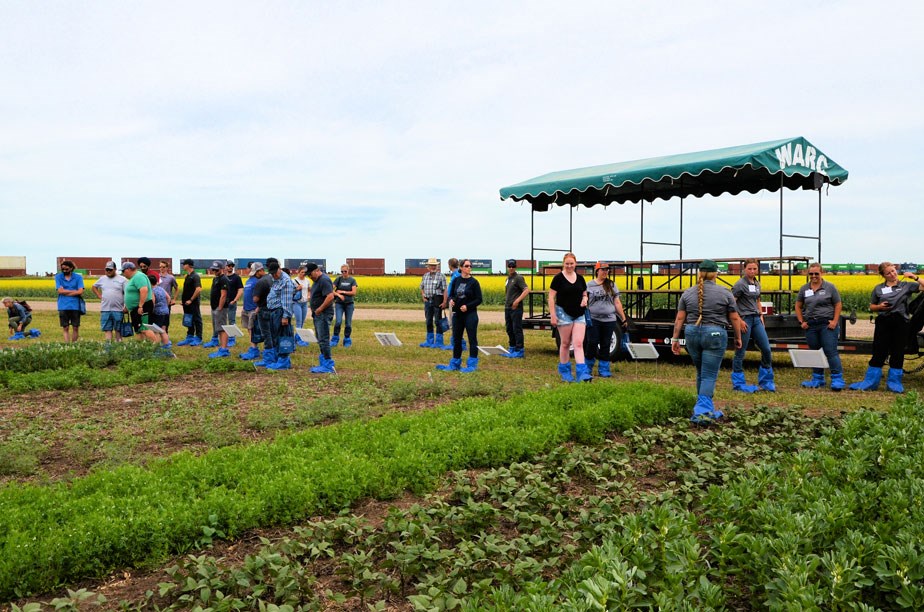SCOTT — After hosting a virtual field day in 2021, Western Applied Research Corporation was happy to welcome farmers and other agriculture specialists, in person, to their test sites at Scott, July 13. Two separate groups – one in the morning and the other in the afternoon – limited to approximately 50 farmers and other agriculture specialists for each session, were taken out to the fields where researchers explained the reasoning and results to date of some of WARC’s current small plot field research trials.
The first stop was at test plots housing new and novel pulse crops. Green and yellow peas had also been planted for comparison purposes. Other plots housed faba beans, dry beans, red lentils, Kabuli chickpeas, cow peas, mung beans, fenugreek and lupins.
In order to make true comparisons, none of the seeds were inoculated due to difficulty in getting product for some of them. The Kabuli chickpeas had “terrible emergence” as described by WARC General Manager Jessica Enns, and indeed that plot had large bare patches with nothing growing. Enns said “double inoculation is not a bad idea” if growing chickpeas.
The market potential for each crop was outlined, as well as preferred growing conditions.
The primary challenge with many of these lesser-known pulse crops is the length to harvest with many requiring well over 100 growing days, in some cases pushing harvest to the end of October. Although lupins require 112 frost-free days, there is a demand for lupin seeds which are of interest due to their high fibre and 40 per cent protein content. (Note: perennial flower varities of lupin are toxic, and not edible. The edible species being considered are annual lupins.)
In order to test weed resistance, second plots of the pulse crops had not had any herbicide applied and variations could be visually seen in the amount of volunteer canola growing amongst the pulses.
The pulse crop presentation was prepared by Sherrilyn Phelps with Saskatchewan Pulse Growers, delivered by her in the morning, and delivered by Enns in the afternoon.
The second set of test plots examined were those evaluating the seeding rate of wheat in drought conditions. Comparisons were made, not only among the plots at Scott, but also to test plots at Regina, Indian Head and Swift Current. Higher seeding rates do not always result in a larger harvest and, in terms of in-farm application, the suggestion was made to lower seed rates on hilltops.
Speakers part of field day experience
Warren Ward of Springside, agronomy specialist with the Canola Council of Canada, explained the research on comparing liquid and granular forms of starter phosphorus when growing canola. Different amounts of each type were added to the plots, and a control plot had no phosphorus added at all.
As it is still prior to harvest, no conclusions could yet be drawn from the study, but Ward stressed the important of not over applying chemicals. He outlined the four Rs: the right rate, the right time, the right placement and the right source. He suggested producers self test by turning off their seed-placed fertilizer for 100 feet, then turning it on again, and subsequently doing plant counts to see if they have an issue with seed safety.
Enns took over the microphone again at the camelina seeding trial, which tested both seeding rates and depths in order to improve yield and maturity. She said the demand for camelina is high and it has greater frost tolerance than canola. The seed is even smaller than canola seed so depth and rate matter and one conclusion already reached from the trials is that three-quarters of an inch is “just too deep.”
Tanton Archdekin, who farms between Landis and Biggar and has added camelina to his rotation, spoke on his practical experiences in growing camelina. He seeds it at a depth of three-eights of an inch, but noted it won’t germinate until it rains. Last year it did “exceptionally well” for him despite the heat but was not doing quite as well this year, presumably due to the lack of residual moisture. He has found it to be flea beetle tolerant.
The difficulties posed by cadmium in flax were addressed by Wayne Thompson of Saskatoon, executive director of Saskatchewan Flax Development Commission, and Anne Nerbas, SaskFlax agronomist. The European Union, one of Canada’s three largest markets for flax, has imposed new lower limits on cadmium in flaxseed.
Funding is going into research on breeding new, low cadmium varieties but that is a long-term solution so, in the short term, testing is being done of side-banding zinc and/or gypsum. Zinc is being studied because flax plants prefer to take up zinc as opposed to cadmium. Gypsum on the other hand increases the PH of the soil and cadmium is more available to plants in a low PH soil.
The results of the study will not be known until after harvest and analysis of the resulting seeds but, if it appears that either of these methods will work, then the research will be extended to a three-year project at multiple sites. Economic feasibility of the treatments will also be reviewed.
In the meantime, said Thompson, “Don’t overfertilize.”
Jesse Bond, a crops extension specialist with Saskatchewan Agriculture, explained the plots examining enhanced agronomy in new barley varieties, three feed and three malt. Seven different treatments are being tested: phosphorus, potassium, nitrogen, seed treatment, seeding rate, plant growth regulator and fungicides.
Enns and Bond ended the tour by asking for research recommendations from farmers. “What matters to you?” they asked. WARC’s mandate is to “transfer technology from research to Saskatchewan producers and evaluate the economic impact of this technology.”
(The Agri-Food Canada Research Farm at Scott, normally a co-host of the field day, did not take part this year and their trials were not part of the tour due to still strict federal public health regulations.)




